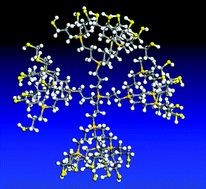Treatment of the allyl-containing compounds Me2Si(CH2CH![[double bond, length as m-dash]](https://www.rsc.org/images/entities/char_e001.gif) CH2)2 and MeSi(CH2CH
CH2)2 and MeSi(CH2CH![[double bond, length as m-dash]](https://www.rsc.org/images/entities/char_e001.gif) CH2)3 with thioacetic acid in the presence of AIBN gave Me2Si[(CH2)3SC(O)CH3]2 and MeSi[(CH2)3SC(O)CH3]3, respectively, which were reduced with LiAlH4 to the dithiols Me2Si[(CH2)3SH]2
(3) and MeSi[(CH2)3SH]3
(4). This protocol was applied to the first and second generations of the doubly and triply-branched carbosilane allyl dendrimers, Si[(CH2)3SiMe(CH2CH
CH2)3 with thioacetic acid in the presence of AIBN gave Me2Si[(CH2)3SC(O)CH3]2 and MeSi[(CH2)3SC(O)CH3]3, respectively, which were reduced with LiAlH4 to the dithiols Me2Si[(CH2)3SH]2
(3) and MeSi[(CH2)3SH]3
(4). This protocol was applied to the first and second generations of the doubly and triply-branched carbosilane allyl dendrimers, Si[(CH2)3SiMe(CH2CH![[double bond, length as m-dash]](https://www.rsc.org/images/entities/char_e001.gif) CH2)2]4
(G(1)allyl-8), Si[(CH2)3SiMe{(CH2)3SiMe(CH2CH
CH2)2]4
(G(1)allyl-8), Si[(CH2)3SiMe{(CH2)3SiMe(CH2CH![[double bond, length as m-dash]](https://www.rsc.org/images/entities/char_e001.gif) CH2)2}2]4
(G(2)allyl-16), Si[(CH2)3Si(CH2CH
CH2)2}2]4
(G(2)allyl-16), Si[(CH2)3Si(CH2CH![[double bond, length as m-dash]](https://www.rsc.org/images/entities/char_e001.gif) CH2)3]4
(G(1)allyl-12), and Si[(CH2)3Si{(CH2)3Si(CH2CH
CH2)3]4
(G(1)allyl-12), and Si[(CH2)3Si{(CH2)3Si(CH2CH![[double bond, length as m-dash]](https://www.rsc.org/images/entities/char_e001.gif) CH2)3}3]4
(G(2)allyl-36) to give the corresponding SH functionalised surface dendrimers Si[(CH2)3SiMe(CH2CH2CH2SH)2]4
(G(1)SH-8), G(2)SH-16, G(1)SH-12, and G(2)SH-36. Reactions of 3 with [M(acac)(diolefin)]
(M = Rh, Ir; diolefin = 1,5-cyclooctadiene, 2,5-norbornadiene) gave the compounds of the type [M2(µ-Me2Si[(CH2)3S]2)(diolefin)2]n. These diolefin complexes are octanuclear (n
= 4) in solution while the complex [Rh2(µ-Me2Si[(CH2)3S]2)(cod)2]n
(5) is tetranuclear in the solid state. The structure of 5, solved by X-ray diffraction methods, consists of a 20-membered metallomacrocycle formed by two dimethylbis(propylthiolate)silane moieties bridging four fragments Rh(cod) in a µ2 fashion through the sulfur atoms. Treatment of [Rh(acac)(CO)2] with 3 gave [Rh2(µ-Me2Si[(CH2)3S]2)(CO)4]n, which is a mixture of tetra (n
= 2) and octanuclear (n
= 4) complexes in a 2 : 1 ratio in solution, while the related complex [Rh2(µ-Me2Si[(CH2)3S]2)(CO)2(PPh3)2]2 is tetranuclear. Reactions of [Rh(acac)(L–L)]
(L–L = cod, (CO)2, (CO)(PPh3)) with 4 and the dendrimers G(1)SH-8, G(2)SH-16, and G(1)SH-12, gave microcrystalline solids of formulae [Rh3(MeSi[(CH2)3S]3)(L–L)3]n, [Si[(CH2)3SiMe{(CH2)3SRh(cod)}2]4]n
([G(1)Rh(cod)-8]n), [Si[(CH2)3Si{(CH2)3SRh(cod)}3]4]n
([G(1)Rh(cod)-12]n), etc., which presumably are tridimensional coordination polymers.
CH2)3}3]4
(G(2)allyl-36) to give the corresponding SH functionalised surface dendrimers Si[(CH2)3SiMe(CH2CH2CH2SH)2]4
(G(1)SH-8), G(2)SH-16, G(1)SH-12, and G(2)SH-36. Reactions of 3 with [M(acac)(diolefin)]
(M = Rh, Ir; diolefin = 1,5-cyclooctadiene, 2,5-norbornadiene) gave the compounds of the type [M2(µ-Me2Si[(CH2)3S]2)(diolefin)2]n. These diolefin complexes are octanuclear (n
= 4) in solution while the complex [Rh2(µ-Me2Si[(CH2)3S]2)(cod)2]n
(5) is tetranuclear in the solid state. The structure of 5, solved by X-ray diffraction methods, consists of a 20-membered metallomacrocycle formed by two dimethylbis(propylthiolate)silane moieties bridging four fragments Rh(cod) in a µ2 fashion through the sulfur atoms. Treatment of [Rh(acac)(CO)2] with 3 gave [Rh2(µ-Me2Si[(CH2)3S]2)(CO)4]n, which is a mixture of tetra (n
= 2) and octanuclear (n
= 4) complexes in a 2 : 1 ratio in solution, while the related complex [Rh2(µ-Me2Si[(CH2)3S]2)(CO)2(PPh3)2]2 is tetranuclear. Reactions of [Rh(acac)(L–L)]
(L–L = cod, (CO)2, (CO)(PPh3)) with 4 and the dendrimers G(1)SH-8, G(2)SH-16, and G(1)SH-12, gave microcrystalline solids of formulae [Rh3(MeSi[(CH2)3S]3)(L–L)3]n, [Si[(CH2)3SiMe{(CH2)3SRh(cod)}2]4]n
([G(1)Rh(cod)-8]n), [Si[(CH2)3Si{(CH2)3SRh(cod)}3]4]n
([G(1)Rh(cod)-12]n), etc., which presumably are tridimensional coordination polymers.
![[double bond, length as m-dash]](https://www.rsc.org/images/entities/char_e001.gif) CH2)2 and MeSi(CH2CH
CH2)2 and MeSi(CH2CH![[double bond, length as m-dash]](https://www.rsc.org/images/entities/char_e001.gif) CH2)3 with
CH2)3 with ![[double bond, length as m-dash]](https://www.rsc.org/images/entities/char_e001.gif) CH2)2]4
(G(1)allyl-8), Si[(CH2)3SiMe{(CH2)3SiMe(CH2CH
CH2)2]4
(G(1)allyl-8), Si[(CH2)3SiMe{(CH2)3SiMe(CH2CH![[double bond, length as m-dash]](https://www.rsc.org/images/entities/char_e001.gif) CH2)2}2]4
(G(2)allyl-16), Si[(CH2)3Si(CH2CH
CH2)2}2]4
(G(2)allyl-16), Si[(CH2)3Si(CH2CH![[double bond, length as m-dash]](https://www.rsc.org/images/entities/char_e001.gif) CH2)3]4
(G(1)allyl-12), and Si[(CH2)3Si{(CH2)3Si(CH2CH
CH2)3]4
(G(1)allyl-12), and Si[(CH2)3Si{(CH2)3Si(CH2CH![[double bond, length as m-dash]](https://www.rsc.org/images/entities/char_e001.gif) CH2)3}3]4
(G(2)allyl-36) to give the corresponding SH functionalised surface dendrimers Si[(CH2)3SiMe(CH2CH2CH2SH)2]4
(G(1)SH-8), G(2)SH-16, G(1)SH-12, and G(2)SH-36. Reactions of 3 with [M(acac)(diolefin)]
(M = Rh, Ir; diolefin =
CH2)3}3]4
(G(2)allyl-36) to give the corresponding SH functionalised surface dendrimers Si[(CH2)3SiMe(CH2CH2CH2SH)2]4
(G(1)SH-8), G(2)SH-16, G(1)SH-12, and G(2)SH-36. Reactions of 3 with [M(acac)(diolefin)]
(M = Rh, Ir; diolefin = 

 Please wait while we load your content...
Please wait while we load your content...